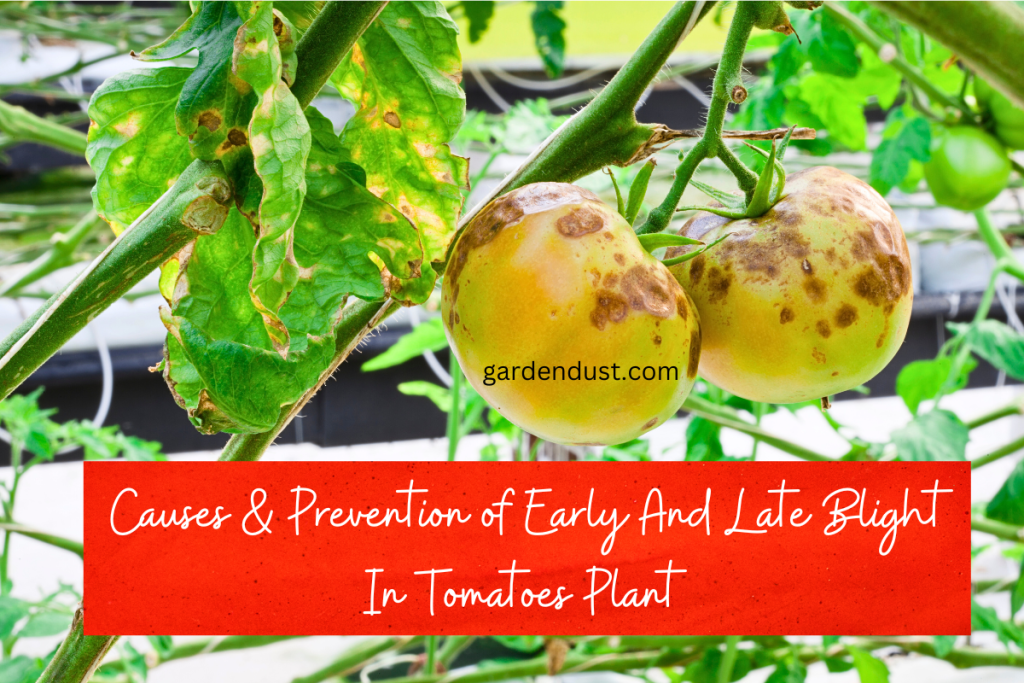Early and Late Blight are two common fungal diseases that affect tomato plants, causing significant damage to the foliage, stems, and fruits. Understanding the causes & prevention of Early and Late Blight in tomatoes plant. Let’s explore each aspect in detail:
Symptoms of Early Blight:
Early Blight, caused by the fungus Alternaria solani, primarily affects the foliage of tomato plants. Symptoms include:
- Leaf spots: Small, dark brown or black spots with concentric rings develop on the lower leaves. As the disease progresses, the spots enlarge and can merge together.
- Target-like pattern: The spots on the leaves often have a target-like appearance with alternating rings of dark and light colors.
- Yellowing and wilting: Infected leaves may turn yellow and eventually wilt, starting from the bottom of the plant.
- Stem lesions: In severe cases, Early Blight can cause lesions on the stems of tomato plants, leading to girdling and potential plant collapse.
Symptoms of Late Blight:
Late Blight, caused by the fungus-like organism Phytophthora infestans, affects the foliage, stems, and fruits of tomato plants. Symptoms include:
- Leaf lesions: Large, water-soaked lesions develop on the leaves, usually starting at the edges and tips. These lesions rapidly expand and turn dark brown or black.
- White mold growth: Under humid conditions, a white, fuzzy mold growth may appear on the undersides of infected leaves. This is a characteristic feature of Late Blight.
- Stem lesions: Late Blight can cause dark lesions on the stems of tomato plants, which can lead to wilting and collapse of the plant.
- Fruit rot: If Late Blight affects the fruits, they develop dark, firm lesions that can quickly spread and cause rotting.
READ ALSO :-15 Common Problems with Garden Cabbage Plants
Causes of Early and Late Blight:
Both Early and Late Blight are caused by fungal pathogens that can survive in soil, plant debris, or infected plants. Several factors contribute to their development and spread, including:
- Humid and wet conditions: Early and Late Blight thrive in cool, humid, and wet weather conditions, especially during periods of extended leaf wetness or frequent rain showers.
- Spore dissemination: The pathogens produce spores that can be carried by wind, water splashes, or garden tools, allowing them to spread and infect nearby plants.
- Plant debris and infected transplants: The pathogens can overwinter in infected plant debris or remain on infected transplants, serving as a source of infection for new plants in the following season.
Prevention For Early And Late Blight:
While complete eradication of Early and Late Blight may be challenging, several measures can help manage and reduce the impact of these diseases:
- Crop rotation: Practice crop rotation by avoiding planting tomatoes or other Solanaceous plants in the same location for at least two to three years. This breaks the disease cycle and reduces the risk of reinfestation.
- Proper plant spacing: Provide adequate spacing between tomato plants to allow for good air circulation. This helps reduce humidity around the plants and minimizes the chances of infection.
- Mulching: Apply a layer of organic mulch around the base of tomato plants to prevent soil splashing and minimize contact between the leaves and the soil, reducing the risk of infection.
- Fungicides: In severe cases or when conditions are highly conducive to disease development, fungicides labeled for Early or Late Blight control can be applied. Follow the instructions on the product label and apply as a preventive or curative treatment.
- Removal of infected plant parts: Regularly inspect your tomato plants for signs of infection and promptly remove and destroy any infected leaves, stems, or fruits. Dispose of the infected plant debris properly to prevent the spread of the pathogens.
Final Thoughts
Early and Late Blight are fungal diseases that can cause significant damage to tomato plants and reduce yields. By implementing preventive measures such as crop rotation, proper plant spacing, mulching, and timely removal of infected plant parts, along with the use of fungicides when necessary, you can effectively manage Early and Late Blight and protect your tomato plants. Regular monitoring and early intervention are key to preventing extensive damage and ensuring a healthy tomato harvest. Happy Gardening…







